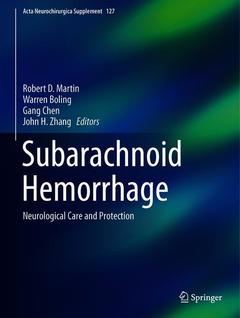Subarachnoid Hemorrhage, 1st ed. 2020 Neurological Care and Protection Acta Neurochirurgica Supplement Series, Vol. 127
Coordonnateurs : Martin Robert D., Boling Warren, Chen Gang, Zhang John H.

This book highlights the latest developments in acute and delayed neurovascular injury studies including delayed cerebral vasospasm, early brain injury, micro-circulation compromise, spreading cortical depolarization, neuroinflammation, and long-term cognitive dysfunctions after subarachnoid hemorrhage. About 32 chapters cover original presentations from the 14th international conference on neurovascular events after subarachnoid hemorrhage, held in Los Angeles in October 2017. Neurosurgeons, neurologists, and neuro-ICU practitioners discuss clinical observations, new pilot treatments, clinical trials, academic and industrial interactions, including surgical and endovascular approaches, brain injury monitoring, new developments in brain imaging, ICU management, early brain injury scales and management, counter cortical depolarization management and anti-inflammation management. In addition, animal models used to study acute and delayed neurovascular events, the basic mechanisms of vascular, neuronal, and CSF physiology, new experimental treatment strategies, new frontiers in the treatment of neurovascular injuries, and new research directions are discussed.
Robert D. Martin, M.D. is Professor of the Floyd S. Brauer Chair in Anesthesiology at Loma Linda University, Loma Linda, California and has held this position since 2004. He is a member of the Board of Trustees of Loma Linda University. He is Board Certified in Pain Medicine and Anesthesiology. His primary clinical interests have been in the areas of Cardiac Anesthesiology and Pain. Dr. Martin was a pioneer in developing anesthesiology protocols for infant heart transplantation.
Warren Boling, M.D., FRCSC, FRACS is Professor, Program Director, and Chairman of the Department of Neurosurgery at Loma Linda University, Loma Linda, CA. He is the past president of the Society of Brain Mapping and Therapeutics and a member of the SBMT Board of Directors. He is a member of the Faculty Medical Group of Loma Linda University Board of Directors. Dr Boling is an academic neurosurgeon and investigator, his primary interests are in the research and neurosurgical aspects of brain imaging, epilepsy, neuro-oncology, and international medicine. He is an expert on the fine topographic detail of human neuro-anatomy, which has led to the identification of anatomical and functional relationships in the human brain.
Gang Chen, M.D., Ph.D. is professor and vice Director of the Department of Neurosurgery at The First Affiliated Hospital of Soochow University, Suzhou, China. He also severs as Director of the Translational Stroke Research Team, and as Chair of the Division of Science & Technology. Dr. Chen’s research focuses on subarachnoid hemorrhage (SAH), which is a violent disease affecting the human health. In SAH, Dr. Chen has put forward “Right time, Right therapy” therapeutic principle. He continues to identify novel regulatory mechanisms in candidate proteins such as CyPA/CD147, neurexin-1β/neuroligin-1, etc., and to evaluate the current development, challenges and potential clinical translation of these res
Summarizes the latest studies on acute and delayed neurovascular injuries after subarachnoid hemorrhage
Covers new pilot treatments, clinical trials, academic and industrial interactions
Discusses animal models used to study acute and delayed neurovascular events
Date de parution : 08-2019
Ouvrage de 235 p.
21x27.9 cm



